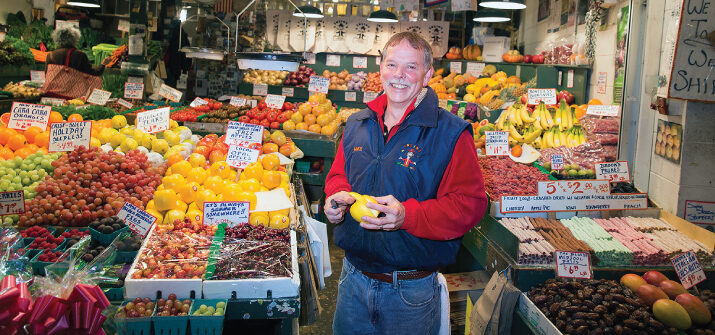Go into any bookstore and you’ll likely see a well-stocked cookbook section. There are cookbooks by continent, country, and geographic region. Some are arranged by meal, by season, or by holiday. Others devote themselves to variations on a single dish such as pasta, soup, or bread.
In her debut cookbook, Viola Buitoni has chosen a new approach: arranging her recipes by ingredient. Italy by Ingredient – Artisanal Foods/Modern Recipes, published in September by Rizzoli with food photography by Molly DeCoudreaux, shows how modern chefs can incorporate robust flavors and simple techniques into their cooking.
Born in Rome and raised in Perugia, Buitoni has lived in the US for 30 years and currently resides in San Francisco’s Mission District with her husband and son. She teaches Italian cooking workshops, in person and online, and leads immersive food tours to Italy twice a year. In 2020, she received the Cavaliere dell’Ordine della Stella d’Italia from the Italian government for her work to enhance the culture and business of Italian food.
Recently Buitoni spoke about her background, new cookbook, and upcoming projects at a presentation at the Book Larder, a community cookbook store in Seattle’s Fremont neighborhood. This interview is based on her remarks that evening.
This is your first cookbook. Why now?
It’s one of those things where you throw a few things at the wall and then see what sticks. Six or seven years ago, as I was thinking about my next project, I kept coming back to the idea of the importance of individual ingredients in Italian cooking. I thought it would be fun to create dishes that crossed fresh locally available products with traditional Italian ingredients. I started off with 135 recipes and pared them down to 75 that appear in the book. My idea was to simplify the preparation to get more people excited about cooking at home. In my recipes, the ingredient list is short so it is not so daunting.
How did the book evolve?
I literally lay down on the floor in my pantry and closed my eyes. When I opened them, I tried to get a fresh perspective on what takes up the most space on my shelves. First, it was pasta. I have a lot of pasta, but you’ll notice there is no chapter on pasta in my book.
Then I realized maybe it’s not how much of one thing you have but more about how often you reach for a certain ingredient, how often you include it in your cooking. For me, that means capers and olives. Nine times out of 10, I go for one of those two ingredients. Other top ingredients for me are anchovy paste and olive oil.
How is your cookbook organized?
The chapters are divided into sections. One section is devoted to condiments, which include balsamic vinegar, capers, and olives. Another section covers cereals, primarily polenta, rice, and farro. There are two chapters on cheese – hard cheeses, such as Pecorino Romano and Parmigiano Reggiano, and soft cheeses that include burrata, mozzarella, and ricotta. The section on meats explores salumi or cured meats, and there is another on fish.
You say it’s important to use all the senses when cooking. Why?
The senses inform the way you cook, how you choose your ingredients, and how you formulate your recipes. One of the questions I get asked the most is: how do you know when a dish is ready? And I always answer: use your senses. This means hearing, sight, smell, and touch. I do not include taste because taste should not come into play until the dish is on the table.
For example, when you heat olive oil, you wait for the olive oil smell to come to you. Don’t put your nose down in it. When it flows up to you, then it’s hot enough. Or, if you hear a sizzle, that means the humidity within the food is being released. Don’t wait until the sizzle becomes a screech. That’s the food saying: help me! By the time you smell something burning, it’s too late. Follow your senses. Touch the food, listen to it, smell it.
Is it possible to cook delicious food on a limited budget?
I think you can cook well on a budget. Buy capers, olives, tomatoes and anchovies. These will elevate your cooking to a new level. Or buy one expensive ingredient that you don’t use a lot of, like balsamic vinegar or a good tomato paste. My pantry and its ingredients make my house a home.
Tell us about your food tours to Italy?
Twice a year, I organize and lead food tours for up to eight people for nine days. I chose this nine-day time frame because there’s a certain cadence to the week in Italy where food is concerned. There is a market day, fish day, pasta day, and so on, throughout the week. On my tours, we visit food producers and growers in the Le Marche region. We cook together and explore the culture and heritage of the area. I offer one food tour in the spring when everything is green and fresh and growing, and a second one in the fall when we might dig for our food, such as truffles, mushrooms, and chestnuts.
Le Marche has such a long and beautiful history. There is nothing super-big or famous there. But that is good because it means there are not a lot of tourists. The locals have a vested interest in keeping their region healthy and productive.
Entra in una qualsiasi libreria e probabilmente vedrai una sezione di libri di cucina ben fornita. Esistono libri di cucina per continente, Paese e regione geografica. Alcuni sono organizzati per pasto, stagione o festività. Altri si dedicano a variazioni su un piatto unico come pasta, zuppa o pane.
Nel suo libro di cucina d’esordio, Viola Buitoni ha scelto un approccio nuovo: ordinare le sue ricette per ingrediente. Italy by Ingredient – Artisanal Foods/Modern Recipes, pubblicato a settembre da Rizzoli con fotografie di cibo di Molly DeCoudreaux, mostra come gli chef moderni possano incorporare sapori robusti e tecniche semplici nella loro cucina.
Nata a Roma e cresciuta a Perugia, Buitoni vive negli Stati Uniti da 30 anni e attualmente risiede nel Mission District di San Francisco con suo marito e suo figlio. Tiene laboratori di cucina italiana, di persona e online, e conduce tour gastronomici immersivi in Italia due volte l’anno. Nel 2020 ha ricevuto il titolo di Cavaliere dell’Ordine della Stella d’Italia dal governo italiano per il suo lavoro volto a valorizzare la cultura e il business del cibo italiano.
Recentemente, Buitoni ha parlato del suo background, del nuovo libro di cucina e dei progetti imminenti in una presentazione al Book Larder, un negozio di libri di cucina comunitario nel quartiere Fremont di Seattle. Questa intervista è basata sulle sue osservazioni espresse quella sera.
Questo è il suo primo libro di cucina. Perché ora?
È una di quelle cose in cui lanci alcune cose contro il muro e poi vedi cosa rimane. Sei o sette anni fa, mentre pensavo al mio prossimo progetto, continuavo a tornare all’idea dell’importanza dei singoli ingredienti nella cucina italiana. Ho pensato che sarebbe stato divertente creare piatti che unissero prodotti freschi disponibili localmente con ingredienti tradizionali italiani. Ho iniziato con 135 ricette e le ho ridotte alle 75 che compaiono nel libro. La mia idea era semplificare la preparazione per far appassionare più persone alla cucina di casa. Nelle mie ricette, la lista degli ingredienti è breve, quindi non è così scoraggiante.
Come si è evoluto il libro?
Mi sono letteralmente sdraiata sul pavimento nella mia dispensa e ho chiuso gli occhi. Quando li ho aperti, ho cercato di avere una nuova prospettiva su ciò che occupa più spazio sui miei scaffali. Innanzitutto la pasta. Ho molta pasta, ma noterai che non c’è un capitolo sulla pasta nel mio libro.
Poi ho capito che forse non è importante quanto hai di una cosa, ma piuttosto quanto spesso prendi un determinato ingrediente, quanto spesso lo includi nella tua cucina. Per me questo avviene con capperi e olive. Nove volte su 10 scelgo uno di questi due ingredienti. Altri ingredienti top per me sono la pasta di acciughe e l’olio d’oliva.
Come è organizzato il libro di cucina?
I capitoli sono divisi in sezioni. Una sezione è dedicata ai condimenti, tra cui aceto balsamico, capperi e olive. Un’altra sezione riguarda i cereali, principalmente polenta, riso e farro. Ci sono due capitoli sui formaggi: formaggi a pasta dura, come il Pecorino Romano e il Parmigiano Reggiano, e formaggi a pasta molle che includono burrata, mozzarella e ricotta. La sezione sulle carni esplora i salumi e ce n’è un’altra sul pesce.
Dice che è importante usare tutti i sensi quando si cucina. Perché?
I sensi influenzano il modo in cui cucini, come scegli gli ingredienti e come formuli le ricette. Una delle domande che mi viene posta più spesso è: come si fa a sapere quando un piatto è pronto? E io rispondo sempre: usa i tuoi sensi. Ciò significa udito, vista, olfatto e tatto. Non includo il gusto perché il gusto non deve entrare in gioco finché il piatto non è in tavola.
Ad esempio, quando riscaldi l’olio d’oliva, aspetti che l’odore dell’olio ti arrivi. Non ci metti il naso dentro. Quando scorre verso di te, allora è abbastanza caldo. Oppure, se senti uno sfrigolio, significa che viene rilasciata l’umidità all’interno del cibo. Non bisogna aspettare che lo sfrigolio diventi uno stridio. Questo è quando il cibo dice: aiutami! Quando senti odore di bruciato, è troppo tardi. Segui i tuoi sensi. Tocca il cibo, ascoltalo, annusalo.
È possibile cucinare piatti deliziosi con un budget limitato?
Penso che si possa cucinare bene con un budget limitato. Acquista capperi, olive, pomodori e acciughe. Questi eleveranno la tua cucina a un nuovo livello. Oppure acquista un ingrediente costoso che non usi molto, come l’aceto balsamico o un buon concentrato di pomodoro. La mia dispensa e i suoi ingredienti rendono la mia casa una vera casa.
Ci racconta dei suoi tour enogastronomici in Italia?
Due volte l’anno organizzo e conduco tour gastronomici per un massimo di otto persone per nove giorni. Ho scelto questo arco temporale di nove giorni perché in Italia c’è una certa cadenza settimanale per quanto riguarda il cibo. C’è un giorno di mercato, un giorno di pesce, un giorno di pasta e così via, nel corso di tutta la settimana. Durante i miei tour visitiamo produttori e coltivatori di cibo nella regione Marche. Cuciniamo insieme ed esploriamo la cultura e il patrimonio della zona. Offro un tour gastronomico in primavera, quando tutto è verde, fresco e in crescita, e un secondo in autunno, quando potremmo scavare per cercare il nostro cibo, come tartufi, funghi e castagne.
Le Marche hanno una storia così lunga e bella. Non c’è niente di super grande o famoso lì. Ma questo è un bene perché significa che non ci sono molti turisti. La gente del posto ha tutto l’interesse a mantenere la propria regione sana e produttiva.































